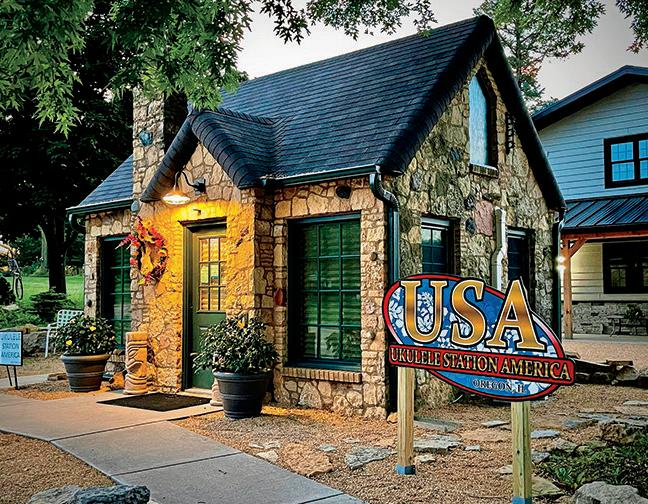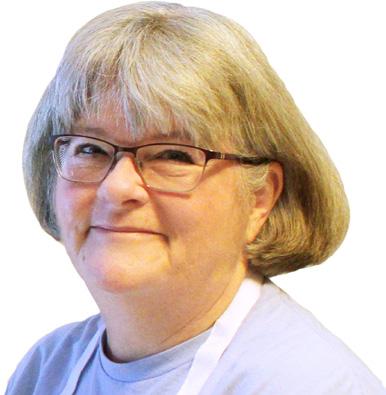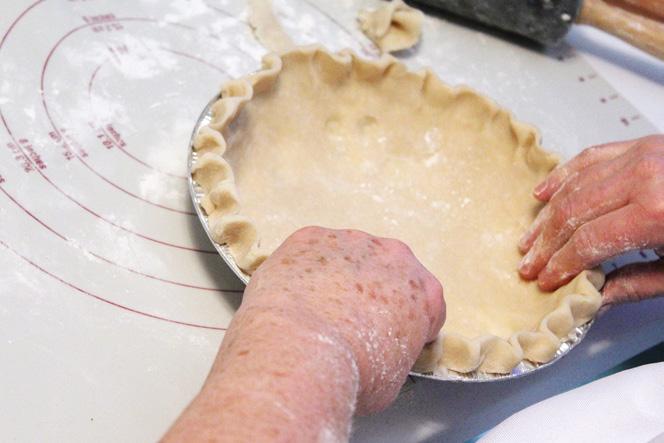Perseverance
Morrison
Finding











The perfect piece, the perfect fit, the perfect gift — you can find them all at Sandlin’s in Erie.
12 A scrappy fighter
Hard work and hard-won bouts ... it hasn’t always been easy for the owner of a Lyndon jiu jitsu studio, but he’s managed to grow a backyard hobby into a downtown destination for students who want to learn lessons in perseverance, discipline and determination.
18 Buy buy, Mrs. American pies
The Morrison “Pie Lady’s” sweet treats score a perfect tin with her loyal customers.
24 Having some cents of history
Centennial, quasquicentennial, sesquicentennnial, bicentennial, dosquicentennial ... Whiteside County can observe them all this year, from a forgotten village high school to boats that got the lead out, and more.






you’re looking for gifts, fashion, decor and more in Erie, what’s the first name that comes to mind? Sandlin? Ashleigh Sandrock hopes so. But if her shop does pop into your head, it’s a last name that’s come to mind — two of them, actually.
Like the business itself, the name of Sandrock’s shop shows her fondness for bringing things together. At Sandlin, she brings merchandise and customers together to find a perfect match, and on the sign out front, she brings two names together: one she took and one she was given.
Sandlin is combination of her married name and

maiden name, Dillin, but that portmanteau isn’t the only thing that’s blended about her downtown business. Her inventory is, too. The store carries an eclectic mix of merchandise that sets her small-town shop apart from big box stores.
“Our goal is to carry unique things, so that people want to come shop here and not go to Hobby Lobby,” Sandrock said. “You’re going to get good quality here. There’s just something about coming in here and someone speaking to you, working with you, instead of shopping aisles.”



Sandrock prides herself being able to play matchmaker with the merchandise in her store and the people who walk through the door. She likes to take the time to find out what they’re looking for and help them find it — and if they don’t know what they’re looking for, that’s OK. She can still find it. When the store’s open, it’s not simply business time, it’s social time, too. She enjoys getting to know her customers and helping them discover new ideas and trends that’ll dress up their home or dress up their wardrobe.
“I enjoy working with people,” Sandrock said. “This is just something that I love to do. I love to help people. People will come in all of the time and go, ‘I don’t know

what I want, I’m sorry to bother you.’ You are not a bother. They’ll bring a picture of a shelf and go, ‘What should I put on this?’ I’ll go put things together for them.”
When it comes to stocking her store, Sandrock prefers a more personal approaching, seeing things up close rather than just picking and clicking online and hoping for the best. She likes to learn about the things she carries, too, and pass that knowledge along to customers. To do that, she travels to vendor markets across the country, including a recent one in Atlanta in January.

“With quality, I needed to know. I had thousands of catalogs that I needed to go through, and you can look in a catalog and go, ‘Oh, that’s cute!’ But when it comes in, it’ll be like a thin piece of wood and not real wood. I don’t want that. I want the real thing.”
It’s those personal connections and going the extra miles that gives Sandlin an advantage over other similar stores. During her Atlanta trip, she discovered a line of decor from a family business in Pennsylvania that makes picture frames from old barnwood. Sandrock got to meet with the owners and found they shared the kind of country roots that she, and many of her customers, have.

Sandrock’s love of country life and her community has gone a long way in helping her store succeed. She grew up there and has a lot of friends and family who continue to live in the area, including her parents.












Having a store like Sandlin was something Sandrock and her mother, Tami Dillin, had thought about it since the time Mom wanted to decorate the family kitchen with a cherry motif, but found the selection in stores at the time was the pits, so she took matters into her own hands.
“My mom’s always been very creative, unique and out-of-thebox,” Sandrock said. “I’ll never forget the time she wanted cherries in her kitchen, and she couldn’t find cherries anywhere. Then she finally just ended up making her own stuff to decorate her kitchen, and then about two years later, cherries were the big thing — cherry pictures, cherry wallpaper, cherry towels, everything cherry.”
That experience stuck in Ashleigh’s mind and helped lead to a her flair for fashion and talent for design, and a strong motherdaughter bond.
When Sandrock and her mom would go on shopping trips, they’d keep an eye out for the kinds of things they couldn’t find back home; it’s that same philosophy Sandrock uses to pick out her store’s inventory.
“We’ve always traveled to Chicago and looked inside little boutiques to try and find unique things, because we wanted what everybody else doesn’t have,” Sandrock said. “The same with clothing, vehicles, everything in the house: I didn’t want what everyone else had.




The dream of owning her own store took shape in 2022 when Betty Warkins, a friend of the Dillin family, offered to sell her downtown building to Sandrock. The building needed a lot of work, so Sandrock and her family rolled up their sleeves and spent about a year completely redoing the inside and restoring the exterior. Outside, the brick exterior is painted black with gold trim and cornices, Betty’s favorite colors. The interior’s original tin ceiling has been restored, and painted gold.


Sandlin welcomed its first customers July 21, and business has picked up since. Sandrock runs the store while her parents, including her father Gail, and her children help out occasionally. As business has grown, so has the selection. When it opened, Sandlin was largely a home decor store, but it’s since expanded its inventory to include gifts and a bigger selection of clothing, from three racks when it opened to eight today. Sizes range from small to 3X, and sometimes an extra small will find its way to the racks, but not often.
The clothing racks help make the shopping experience easier, with black or gray felt on each one — black for small to large, and gray for bigger sizes, making it easier to find your sizes.
Sandlin also offers a gift registry, to help gift-buyers know what to pick out for that special occasion. But even if they don’t know what to buy, Sandrock is more than happy to help the find just the right fit.















SANDLIN cont’d from page 10
“The amount of people who come in and go, ‘I forgot it was my mom’s birthday today, I need a gift,’ No problem, we can do that,” Sandrock said. “They’re so excited that they don’t have to go out of town or order online. I had a lady come in on her way to a recent concert, and went, ‘I need an outfit for tonight!’ No problem. She didn’t want to drive to The Cities; she didn’t want to drive to Sterling.”
The success Sandrock is enjoying so far has given her opportunities to broaden her business scope. She carries the Fusion line of mineral paints at the store, and is planning workshop classes to help people get the most out of them while painting or touching up furniture and smaller items. She also has taken her interior design skills to the next level, announcing in February that she can visit homes and help people incorporate what they’ve bought at her store with their existing home decor.
Sandrock is thankful for the support she’s gotten from her hometown, for helping to turn her dream into a reality; and its added to a revitalized downtown area that has seen several new businesses start up to give people from out a town a reason to visit, and people from town a reason
shop local.
“We haven’t been here very long,” Sandrock said, “but it’s been good.”
Cody Cutter can be reached at 815-632-2532 or ccutter@shawmedia.com.

















































































 BY CODY CUTTER SAUK VALLEY MEDIA
BY CODY CUTTER SAUK VALLEY MEDIA
amian Hall’s journey in combat sports has quite the humble beginning.
It’s not just that he got his start in the small town of Lyndon, but his story began in a tiny makeshift studio in his back yard.
What a difference a few years can make.
Today, Hall’s hard work and skill in combat sports have found a following, and a new home too, where he’s teaching and inspiring others.
Hall owns The Scrap Shack, where he teaches jiu jitsu, kickboxing, traditional boxing and freestyle wrestling to children and adults in a downtown building that’s he’s also fixing up. From a backyard shack to his own studio, Hall’s story is one of determination. It’s also a lesson his students can learn from.
SCRAP SHACK cont’d to page 14
It took hard work and help, but the building that The Scrap Shack calls home has come a long way from a run down former feed store that was damaged by fire.

“We’ve built that mentality that hard work can get you anywhere,” Hall said. “We started with a place that had no roof in the back, and it was all fallen through. We took this place from something nobody wanted to a place that’s really running.”
Hall originally taught from his back yard for about a year and a half before moving to a garage in town that offered more space for his students. He moved again last year, to his current location, a former feed store that had been damaged in a fire about 20 years ago. Hall bought it in May and he and his friends have been restoring it since.
He had been teaching for free, but decided to charge a fee, with a plan to use the money to fix up the building. His students stuck by him, and he also received financial help through local sponsors. After fixing the damaged roof, they put together a room with a few wrestling mats they acquired from local schools, punching and kicking bags, and workout equipment. Plans to build a lobby room and restrooms are in the works.

Like the students he coaches, the studio is a work in progress, getting better every day — and just because the building’s roof has been fixed, that doesn’t mean Hall and his students can’t still reach for the sky.
























“You’ll look around and won’t see the nice, painted drywall, or the finished floor, or see a plywood ceiling with paint thrown on it,” Hall said. “It’s not pretty, but that makes it what it is – it’s a scrap shack, it’s thrown together, it’s as good as we can do it, and it’s growing every day, just like how our guys are growing every day as we get better with this facility. You won’t find the pretty finish in here, but you’ll find a lot of hard-working guys here who don’t care about that.”
Jiu jitsu is the gym’s primary focus. Its roots originate in Brazil, and consists of grappling, ground fighting and the application of submission holds. It’s a method that benefits smaller fighters against larger opponents by way of leverage and weight distribution.
Since The Scrap Shack began in 2020, its fighters have brought home nearly 80 medals from regional and national competitions, displayed proudly along one of the gym’s walls. They serve as visual motivation for the next up-and-coming fighter to add to the collection, give their gym added recognition, and — most importantly — improve upon themselves.



There’s no shortage of accolades displayed at Hall’s studio, but there’s always room for more, and the team at The Scrap Shack is always working to bring more hardward home.




































The gym enters at least one competition a month. Recent accomplishments include a second-place finish in the adult group at the Newbreed Jiu Jitsu Federation’s Chicago Summer Championship on June 17, and a third-place finish at a Submission Challenge jiu jitsu competition in Des Moines, Iowa, on Aug. 5. In both competitions, they faced competitors from larger gyms in larger towns.
The Scrap Shack owner and instructor Damian Hall oversees a jiu jitsu spar between Tyler Meyers of Rock Falls and Quinton Stage of Morrison. Jiu jitsu is the gym's primary focus, but it also teaches kickboxing, traditional boxing and freestyle wrestling.
While the accomplishments are a point of pride for the gym, there were times when Hall couldn’t help but be disappointed that they didn’t earn a first-place win. Others didn’t quite see it the same way.
“To us, it was like, ‘Well, we didn’t get first,’” Hall said. “Everyone else was like, ‘Dude, you’re from a town of 600 people and you’re competing and winning. It piques a lot of interest. It’s cool to bring something home rather than nothing, but you settle down and stop and think about it and look at what you did.”
But still, that hunger for the top prize always remains.






























“We had a good summer,” Hall said. “We competed a lot. We placed two and three out of 50 to 100 teams a couple of different times. For a first-year gym, it’s almost unheard of. We go out and place well, and we have a lot of guys who come in and work real hard that have never had the technical style of it, but we can go really hard for a long time. We’re quick to look for the next thing right away. We’re in pursuit of that win, and I think this is going to be the year we get it.”
Hall is in the second chapter of his fighting career after concussions cut short his fighting career in jiu jitsu, boxing and kickboxing. He’s stayed in the game through teaching; he initially just wanted to be someone who would plant the fighting spirit in someone before they went off on their own, but then he turned to coaching, sticking with his competitors through their journeys.
“I never really got into this to be a jiu jitsu coach,” Hall said. “I just really wanted to train with my friends. It got to the point where I would see some of my guys lose, and I thought, I’ll have to be a coach. I tried to avoid it, but I just fell in love with it. Just seeing someone go from nothing to winning at tournaments, bringing home medals, and being pretty good at something, it feels good.”

Hall has plenty of help developing talent. Austin Baldwin and Holden Kessel also serve as instructors, and he recently enlisted Morrison kickboxer Quinton Stage to teach kickboxing lessons at the gym. Stage saw how Hall performed as a kickboxer, and it inspired him to compete.
“In all honesty, I just love to fight, whether it’s grappling or striking,” Stage said. “Striking is definitely my favorite thing to do, with being 4-0 as a kickboxer. I got into it after seeing [Damian’s] first fights, and felt like, ‘I could do this.’”
Up to the challenge? Want to take on a new activity? Improve your self-defense techniques? Class schedules can be obtained by calling or e-mail the gym or on social media (see “More Info” elsewhere on this page). On good days, the gym’s mats and workout areas are full, with about 25 people, but even on slower days, there’s a sparring partner available.
Ross Hughes of Lyndon enjoys making the short trip to the gym when he can, and is glad to see it become a part of Lyndon’s business landscape.
“I love the workout and the atmosphere of working with the guys,” he said.
“It’s a blast. I like kickboxing a lot. The workout, the movement of the body, the flow, it’s just so fun.”
Tyler Meyers of Rock Falls wrestled in high school and college, and enjoys the challenges that come with other forms of one-on-one competition.
“I like it,” Meyers said. “With wrestling, I’ve always been used to being in a dark room working my ass off, and it’s what they do here. I enjoy it.”
So do the rest of Hall’s students who come from near and far — from small towns throughout Whiteside County as well as larger towns, such as Sterling and the Quad Cities — to experience the competitive spirit, build their confidence, and learn the art of self-defense and combat sports.
“I feel like this is a tool for your life, and I’ve seen what it’s done for a lot of people,” Hall said. “Man or woman, you can get in here and change your life.” n
Cody Cutter can be reached at 815-632-2532 or ccutter@shawmedia.com.










ouise Clark was able to parlay a talent into a nickname, and her own little slice of the local food market.
It’s a name that’s short and sweet, and one that she’s earned from delighted dessert lovers near and far who travel to pop-up markets in Morrison and the Mount Carroll farmers market to buy her pies. To them, she’s known as “The Pie Lady.”
“They kind of nicknamed me,” Clark said. Her county-issued cottage kitchen license says she’s Pies, Etc. by Louise — “because I make more than just pies,” she said — but “The Pie Lady” suits her just fine.
“If they want to call me ‘The Pie Lady,’ fine,” she said. “I made it into

a thing.”

 By Cody Cutter | Sauk Valley Media
By Cody Cutter | Sauk Valley Media
That’s not all she’s made. Even though her nickname is all about the pies, she also turns out other sweet treats in her home kitchen in Morrison: cookies — chocolate chip, M&M and snickerdoodle — that are a perfect balance of chewy and crispy, frosted cinnamon rolls, banana and zucchini breads, and even jars of bread-andbutter pickles that offer something different than the usual dill taste.
Louise Clark makes pies and other baked goods from her Morrison home to sell at local markets or by custom order.

But it’s the pies that people can’t get enough of — and it all starts with a good lard-based crust.
“You have to have the crust to make it stay together and hold the pie,” Clark said. “If you don’t have a good crust, the pie’s going to fail. It’s got to be able to hold it all together and not fall apart when you roll it out.”
Clark makes apple, Dutch apple, blueberry, cherry, peach, pecan, rhubarb and strawberry rhubarb pies in both nine-inch, deep-dish tins and smaller sixinch tins. Dutch apple pies have a crumbly streusel topping, while classic apple pies stick with the classic crust. She likes her pies to have plenty of filling.
“I think it’s just the combination of the crust and the filling,” Clark said. “My pet peeve is going to a restaurant and getting a pie that has a quarter-inch thick crust on both sides, and maybe you get about four apple slices, more crust than filling. My pies have approximately between 1-3/4 to 2 pounds of filling, there aren’t even 10 ounces of crust between top and bottom.”
PIE LADY cont’d to page 21


Rhubarb is Clark’s favorite pie, and not just for its taste, but because it helped her go from Louise to “The Pie Lady.”
During a visit to the Morrison Farmers Market several years ago, she was disappointed to find there wasn’t as much produce there as she would have liked.
Instead of complaining about it, she took a stand — or rather, she set one up. She grew some vegetables in her home garden and set up a table at the market. Among her green thumb goodies was plenty of rhubarb, and one day she decided to whip up a few pies, using lessons learned from her mother, to sell at her stand.
“I started baking a few rhubarb pies, and I was amazed about the responses I got,” Clark said, “I would bring just two pies. Then people would send me messages. Someone said, ‘I didn’t think my kids would love rhubarb pie, but they thought it was awesome.’ That encouraged me, and then next time I brought four pies.”
It didn’t take long before there were more pies on her table than produce.
It was at the market that her nickname was born. Another farmers market vendor, Shelli Eng, had established herself in the community as “The Bread Lady,” with her variety of breads, and people picked up on that and started to call Clark “The Pie Lady.”


When the Morrison Farmers Market folded in 2017, Clark started to go to the Mount Carroll Farmers Market, and became a regular vendor the following year. The Mount Carroll market, when she started, had just a handful of vendors, but has since grown to include about 40 different vendors on any given summer Saturday.












Clark’s baked goods have attracted locals, tourists and part-time summer residents near the area. She’s even had customers from places she had never heard of who are on a mission to find “the best pie.”
“I love to see the customers and how happy they are when they come up and oogle over everything,” Clark said. “I love the camaraderie between the other vendors, and the regular customers. It’s great social time for me, too, with living out in the country with no close neighbors. It’s a nice atmosphere when I go there on Saturdays.”
How good are the pies? All Clark has to do is turn around and point to the back of her shirt, which reads “Worth every calorie!”
“A very good friend who I brought a pie to looked and it and went, ‘Oh, I shouldn’t, but ...’” Clark said. And then: “Oh my God, it is worth every calorie!’ I had to use that. She set it in stone for me.”






Clark also sets up at occasional pop-up markets in Morrison, reconnecting with past farmers market customers — and she makes sure to bring plenty of pies, which she manages to sell out almost every time.
“It’s a good problem to have, but I’d feel so bad when people show up after getting off from work” and not be able to pick up a pie, Clark said.
She’ll occasionally announce pre-order windows on her Facebook page, “Pies, Etc. by Louise,” and also accepts orders by phone or email — just don’t expect a pie to pop right out of the oven. She makes sure to let people know that she can’t be hasty in her homemade goods; and she’ll plan her schedule based on that principle.
She has plenty of help from her husband of 35 years, John, who assists in loading up the car for a trip to the farmers markets, as well as lending a hand with set-up and tear-down — and he’s also got another, very important job.
John’s a trusted taste-tester, and his wife’s pies are the only ones he can sink his fork into these days.
“I’m not a huge pie eater, but ever since she started making pies regularly, I cannot eat a piece of pie at a restaurant,” John said. “When you pay four or five bucks for a piece of pie, and it’s mostly crust, it doesn’t make it that great.”

Originally from Evanston, Clark came to the area in 1985 to work as a probation officer for Whiteside County Court Services. She also was a real estate agent, and continues to work for the county on a part-time basis with the assessors department on the Board of Review.
She’s come to love her current chapter in life, and making dessert memories for others.
“I love what I do,” Clark said. “I like that it makes people happy.” n Cody Cutter can be reached at 815-632-2532 or ccutter@shawmedia.com.




hiteside County’s past is full of stories — people, places, facts and figures that have played a part in putting the county on the map and helped tell its tales. Some are well-known, while others can only be found when you dust off the history books and flip through the pages.
All those stories, big and small, have
earned their place in local history books — but some of them just don’t always get their place in the local limelight.
When it comes to celebrating the past, most of the historical hoopla is usually reserved for benchmark anniversaries — 100 years, 200 years, and the like. People don’t tend to get as nostalgic when the 99th or 101st anniversaries come around.
But it’s not just centennial celebrations that bring the past to the present. Double the milestone and double the memories — there are 200 reasons to celebrate bicentennials, just



ask anyone old enough to remember being around for America’s year-long love affair with liberty during its red, white and blue birthday bash in 1976.
Other milestone markers come with some linguistic tongue-twisters, though they don’t tend to get as much attention as centennials and bicentennials. There’s the quasquicentennial for 125 years and sesquicentennnials for 150 years; and when it’s time to mark 175 years, you’ve got several different words you can wrap your tongue around — seven by some counts, including dosquicentennial and septaquintaquinquecentennial (though some who’ve done the math contend some of the terms don’t quite add up, but we’ll leave that to the linguists).
HISTORY cont’d to page 26

Some of Whiteside’s tales from the past have been featured in this magazine, like the story of Alonzo Golder, a farmer from Montmorency Township who started the Illinois State Grange in 1872; how county roads got their names; Deer Grove’s sesquicentennial last year, or how Denrock was at the crossroads — or rather railroad junction — of local history.
In this issue of Small Town Living West, we’ll tell you a few more stories that have reached a milestone this year, tales mostly forgotten, but ones that deserve to be remembered: a village high school in a home, a weekly newspaper’s first edition, a massive tornado, the slicing of the county map, and commerce on The Mississippi.
You might not be able to say “septaquintaquinquecentennial,” but once you’re done reading, you shouldn’t have any trouble saying, “Hmm, now that was interesting.”
Cody Cutter can be reached at 815632-2532 or ccutter@shawmedia.com.

These days, Coleta’s population of about 175 people isn’t enough to warrant its own high school, but that wasn’t always the case.
In the early 1920s, the village had about the same population, but traveling from town to town wasn’t as simple as it is today.
It was also around this time that high school was becoming a more important part of students’ education, so educators at the Coleta School came up with a high school curriculum to keep its older students close to home, saving them from having to travel to Sterling or Milledgeville to continue their education.
It didn’t last long, though. Established in 1920 for grades 9 through 11, its last class dismissed only four years later, in 1924. Those wishing to attend 12th grade had to do so elsewhere.
Coleta’s school building at the time was built in 1875 at the edge of town on South Main Street, with a wing added in 1885. Up until the 1910s, students were required to attend school until age 14. When that age was raised to 16, many schools in villages like Coleta didn’t have the instructors qualified to teach them, so older students had to travel to out of town to get a high school education.
Coleta High School’s first class consisted of 15 students under teacher C.L. Hurless. The new classes were taught in the cloak room, but it didn’t take long before Hurless saw that more space was needed. That was made possible the following year.
COLETA cont’d to page 28







Cyrus Bushman, who was the Genesee Township assessor at the time, rented out his home north of the school for high school classes. Despite the larger space, and whatever expansions to it that Bushman (a carpenter by trade) could create, more space was needed, likely a whole new building — and that meant taxpayers would have to foot the bill to build one.
But higher taxes for higher education weren’t something they were prepared to go along with, and proposals were shot down at the ballot box in 1922 and 1924. With the Bushman home becoming too cramped, the decision was made by the school to discontinue high school classes.
Coleta High School, while small, had school activities and sports teams. Its Mandolin Club often performed at local functions, and the school’s basketball team rounded up enough students to play a game or two against mostly elementary-aged schools; the games against Central School in Sterling were their biggest of note.

Coleta School (1875-1956)
Hurless left the school before its final class, replaced by brother and sister Victor and Myrtle Jacobson. Myrtle later married Cyrus’ son Rothmer, and continued a career in teaching until the 1950s, becoming one of the first teachers at Sterling’s Washington School.
Coleta never revisited the possibility of hosting high school education. The 1875 building was razed in 1956, and a larger consolidated school was built on its site. That school was absorbed into the Sterling School District in 1972 and closed for good in 1979. n
The village’s first high school classes were taught here in 1920, in a cloak roam, until they were moved to the township assessor’s home the following year.

These days, the latest news is always at our fingertips. We type or swipe or click a remote and there it is, but as the turn of the 20th century was preparing to pivot, the fingertips used to get the news were ink-stained, when the local newspaper delivered news, ads and even a bit of local gossip to people’s doorsteps.
It was 125 years ago, in 1899, when George S. McCartney published the first edition of the Albany Review, today known as simply The Review, which covers southwest Whiteside County and northern Rock Island County. The six-column Friday newspaper was published in a two-story brick building at 202 S. Main St., which later became C.F. Lusk and Son’s Dry Goods store, and, most recently, the Rusty Silo gift shop.

The first edition of The Albany Review was published in this building at 202 S. Main St., which later became C.F. Lusk and Son’s Dry Goods store, and most recently, the Rusty Silo gift shop.
Unlike most newspapers of its time, the Albany Review was nonpartisan in politics. McCartney was the nephew of one-time Whiteside County state’s attorney David McCartney, and was known to collect artifacts from ancient and recent history that were displayed above his desk at work. George’s wife, Fannie, also helped with the newspaper’s operation.
Prior to the Review, Albany had been served with a weekly newspaper as early as 1854, called the Albany Herald. Other titles in town during the late 1800s included the Journal, Times, News, and Weekly Herald. The Review outlasted them all, and by 1908 had a circulation of a just over 1,200. McCartney ran the newspaper until his death on May 21, 1920, interrupted only for a brief while when Andrew Galt was in charge.
Harvey Shawver of Morrison bought the Review after McCartney’s death and ran it until Foster Stagg bought it in 1925; Fannie continued to serve as associate editor until her own death that same year. Under Stagg’s ownership, the newspaper was printed in his hometown of Thomson in Carroll County. Printing was brought back to Whiteside County when William Beck Jr. of the Whiteside Sentinel in Morrison bought the paper in 1950. It was under the Sentinel’s ownership that the Albany Review became The Review, and its coverage area expanded to include Erie initially, and later to Cordova, Port Byron, Hillsdale, Rapids City and Hampton.
The Sentinel, later News-Sentinel Corporation, owned The Review for the longest period to date. The News-Sentinel’s quartet of weekly newspapers in the county, which also included those in Fulton, Morrison and Prophetstown, were purchased by Shaw Media — publishers of this magazine — on April 1, 2019.
The Review continues to serve the same area as it has for more than 70 years, today with an increase in county-wide coverage. Earleen Hinton is the current editor. n
Tampico’s early history is a tale of perseverance. In the first few years before the town officially incorporated in 1875, it survived two fires and a tornado; and in 1874 it faced a double-whammy of disaster.
Tampico took root after the Chicago, Burlington and Quincy rolled through in 1871; a post office was established, and a few houses and businesses started to make a home in the country village. In 1872 a fire wiped out some of those newly built structures; and a second fire on Jan. 4, 1874, caused about $35,000 worth of damage.


But as damaging as those fires were, they couldn’t compare to the fearsome force of nature, when a tornado swept through the village nearly five months later, on June 6. It damaged or destroyed property in an area a half-mile long, and apparently was isolated to just the village itself. The largest business in Tampico at the time was the Glassburn and Bryant grain elevators; the two of them contained about 20,000 bushels of grain. T.S. Beach also owned a silo in town, and it and its 2,000 bushels were lost in the cyclone. In all, 21 buildings were destroyed and another 20 damaged. No lives were lost, but the Sterling Standard newspaper reported that several people were severely injured.
Tales from the twister were passed on to future generations, and some even entered local lore. One such account, republished in Fulton Journal editor Wayne Bastian’s 1968 history of Whiteside County reads:
“As usual, there were stories of the seeming vagaries of the aerial meteor and the extremes of the natural phenomenon amazed then even as it does now. There were 11 persons in the home of T.H.C. Down. After the wind passed by, all the members were found except the infant Dow. Rescuers tore away the ruins of the house and found the child, unharmed. A pump at the side of the Dow home was not damaged but the building was blown over it.”
The town wasted little time in rebuilding after the twister, and went on to become incorporated as a village more than seven months later, on Feb. 26, 1875. Still fresh in the minds of the community, the name of Tampico’s first and longest-running newspaper was inspired by the disaster: The Tampico Tornado published from 1876 until 1966 — and during some of its tenure, the newspaper’s motto was: “You get wind of everything in the Tornado.” n








People today know Morrison as Whiteside County’s governmental seat, but that hasn’t always been the case; especially since the town wasn’t settled until 1855, almost 20 years after the county first organized in 1836. However, the county’s seat location had an interesting history hopping between Lyndon and Sterling before it settled in Morrison in 1858.
Prior to its move to Morrison, the seat was located in Sterling, where it had been since 1849 — 175 years ago. The seat came to Sterling after spending seven years in Lyndon, a more central part of the county, and it was the third of four moves of the seat in the county’s history.
For the county’s first three years, a central seat of government was not officially recognized. This changed in 1839 when the Illinois General Assembly approved an act for counties to create one, chosen by public vote. Lyndon was named Whiteside County’s in May 1840 on the sixth ballot. However, a dispute with the voting total resulted in a recount later in the year, which resulted in Sterling being named the new seat. That lasted for two years before the county chose to move the seat back to Lyndon.
In 1846, the county’s commissioners moved the county circuit court to Sterling. Three years later, and unlike the move back to Lyndon, the location of the seat was left up to the voters. The April 3, 1849, election returned the seat to Sterling. The county’s largest city would have the seat for only nine years before another vote handed it to Morrison.
By 1849, most of Whiteside County had been settled except for swaths of land in the southeast portion. That year, a vote to organize the county into townships was put to voters, who approved the township system; but it was soon discovered that there were illegalities to parts of the vote process; the vote was declared void and not voted upon again until two years later. n
Morrison became the county seat in 1858, but not before bouncing back and forth between Lyndon and Sterling. This 1885 map gives a bird’s eye view of Morrison. The courthouse and county offices can be seen atop the hill off of Knox Street, between Cherry and Madison. Morrison’s first courthouse was completed in 1865. The current, courthouse was completed in 1987, near the location of the first courthouse.







We invite you to stop by and enjoy a
shopping








What went on in Whiteside County 200 years ago? No one really knows for sure. What is known, though, is that in 1824, the area was settled by Native Americans of the Sauk and Fox tribes, led by Chief Black Hawk, as well as the Winnebago tribe. During their early years in the area, they laid nary an eye on white settlers, but the Mississippi River changed that. The river was the nation’s major highway at the time, leading westward settlers and east coast proprietors to lands rich in miner als and lumber.
In Whiteside County, the Mississippi River borders the northwest portion, from the mouth of the Meredosia Creek south of Albany to the Carroll County line just north
of Lock and Dam No. 13.
While boats or canoes, or even a log raft like the one Huckleberry Finn floated on, doubtless made their way along Whiteside’s share of the river, no one knows for sure when the first river traffic meandered along the Mississippi near here. Historians are thus left with what happened on the river in 1824 to write a chapter in the county’s history book. That was the year the first steamboats carried lead from Galena down the Mississippi River.
Though steamboat traffic wasn’t unknown at the time, they made only occasional journeys through the Whiteside County area, carrying logs from Minnesota timbers. Steamboat sitings became more commonplace as they chugged down the river, lugging lead from Galena, which had been a mine haven for more than a century prior to the first steamboats carrying lead out of the city.

Steamboat traffic continued to increase on the Mississippi with its access to Galena, and other towns began to settle along its shores. Towns on the local stretch of the river — Albany, Camanche, Clinton, Fulton and Lyons — were founded in the 1830s, and steamboats even played a role in the naming of one: Fulton, named in tribute of Joseph Fulton, who built the world’s first commercially successful steamboat, the Clermont. Today, history is still chugging along in the city: Fulton High School’s sports teams are known as The Steamers. n








































